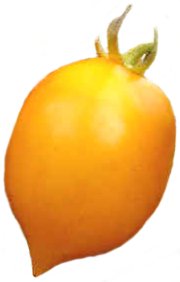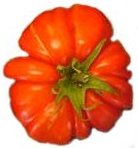

Tomatoes

Lycopersicon lycopersicum. Solanaceae. A short-lived perennial cultivated as an annual for its usually bright red, fleshy fruit. It is an extremely variable species with a growth habit varying from an indeterminate vine attaining a potential length of around 10m in a single growing season, through to compact, determinate bush types. Fruits are borne in clusters known as trusses and may be round, lobed, or pear-shaped, varying in size from 1-12cm in diameter. Cultivated forms are usually red, but may also be orange, yellow or striped. In section, fruits contain cavities or locules filled with seed-containing gel. Most of the smaller, round-fruited cultivars are bilocular in structure, in contrast to the larger-fruited beefsteak types which are multi-locular, producing a more lobed fruit. Lycopersicon lycopersicum variety cerasiforme, or cherry tomato has smaller and more sweetly flavoured fruit than that of the normal type. The tomato originated in the Andean region of South America, mainly in Ecuador and Peru, but its domestication took place in Mexico and Central America. It was introduced into Europe during the early 16th century, and has since been widely distributed. The cultivation of indeterminate types in heated glasshouses probably represents one of the technologically most sophisticated systems of crop production in existence, being particularly advanced in the Netherlands and other countries in Northern Europe. Determinate bush forms are cultivated on an extensive field scale for processing in the US and Southern Europe. Tomato is adapted to a wide range of climatic and soil conditions but cannot withstand frost. The optimum temperature range for growth is 21-24ºC: temperatures below 12ºC cause chilling injury to plant tissue. Mean temperatures greater than 27ºC can also adversely affect growth. High light levels are required for maximum fruit set and high yields. Seed germination takes place at soil temperatures within the range 10-35ºC and is optimum at 30ºC. Flowering and fruit-set are critical stages of crop development and air temperature greater than 38ºC can destroy both pollen and developing embryos. Setting is also poor at high night temperatures of 25-27ºC, although some cultivars selected for the tropics are able to withstand such conditions. Temperatures below 10ºC increase the rate of flower abortion. Fruit ripening is optimum at 18-24ºC but is poor between 13ºC and 10ºC, at which chilling injury occurs both on the plant and, following harvest, during the storage period. 
Within the broad temperature limits the tomato can be grown in a wide range of climates and it has consequently developed into one of the most widely grown crops throughout the world, cultivars having been selected for almost every situation. The main limitation in temperate regions is the number of days above the 10-13ºC chilling threshold, whereas in tropical regions the incidence of pest and diseases, particularly in the humid tropics, poses a greater threat than high temperatures. Fresh outdoor tomatoes are only harvestable during the summer months from temperate regions and, although heated glasshouse production extends the supply to cover most of the year, the poor light in winter in northern latitudes make all-year-round production difficult to achieve and produce is usually imported from regions in lower latitudes. Fresh fruit, picked at an early stage of ripening, can be stored for several days, optimally at a temperature of 13ºC and conditions of high humidity. A sheltered sunny site is essential for outdoor tomato production. The soil should be fertile, well-drained and moisture retentive, with a pH in the range 5.5-7.0. Well-rotted manure or other organic matter should be incorporated into the soil and a balanced fertiliser added before planting. The tomato is susceptible to similar soil-borne pests and diseases as the potato, and the site should therefore be rotated. Alternatively, plants can be raised in containers of potting medium or in growing bags. Plants should be raised from seed during early spring, under protection in temperate climates. The minimum temperature in the seed growing medium should not fall below 10ºC. The seeds can either be sown thinnly in seed trays and pricked out into 5-7.5cm pots, or directly into pots, using two or three seeds to be thinned to one per pot following germination. Plants should be ready to plant outside 6-8 weeks after sowing, when they should be 15-20cm high and their first flowering truss should be visible. The plants must be well hardened off before planting in the open in cooler regions, and if possible continued protection should be provided during the early stages using cloches or perforated plastic sheets. The tall indeterminate cultivars may be planted at 40-45cm apart alongside 1.2m tall canes for training and support. The bush types can be planted between 30-45cm apart and will not need supporting, although a plastic mulch will prevent the developing fruit from being contaminated by soil or attacked by slugs, etc. Sideshoots on indeterminate cultivars should be regularly removed at an early stage of development so that growth is directed into fruit production. Plants must be kept well watered at all times and container-grown plants in particular will require feeding as fruit develops. Potash supply is particularly important for the development of flavour. Pollination is encouraged by shaking the flowering trusses every other day. Depending on the location, it is advisable to stop further growth in late summer by removing the growing point, leaving one leaf above the late formed truss. Typically, 3-5 trusses can be carried per plant grown outdoors and the process of stopping will ensure that all will complete their development before the onset of colder winter conditions. Lower leaves should be removed when they show signs of senescence. For maximum flavour fruits should be permitted to develop their full colour on the plant before harvesting. At the end of the summer, ripening of the final fruits can be accelerated by removing the stakes and laying the still-rooted plants on a layer of straw before covering with cloches. 
Greenhouse tomato production enables better quality fruits to be harvested over a longer period. A wider range of cultivars can be grown under glass and higher yields achieved. Normally only indeterminate cultivars will be selected for such conditions and, as a crop rotation is not usually possible, pot or growing bags must be used unless the border can be sterilised annually using steam or chemicals. Under greenhouse conditions plants are best trained on strong twine in preference to canes. Soilless or hydroponic cultivation of tomatoes may also be practised under greenhouse conditions. In commercial cultivation tomatoes are habitually ‘layered’ so that the fruiting portion of the stem is supported on twine or wires and the older portion lies along the ground, the plants being retied periodically. A large number of cultivars is available and new ones are introduced every year. A small selection of the large numbers of available cultivars includes the following. For use under heated structures (in cold climates): ‘Abunda’, ‘Burpeeana Early Hybrid’, ‘Caruos’, ‘Eurocross BB F1’, ‘Jumbo’, ‘Sonatine’, ‘Tropic’, ‘Vendor’, ‘Vision’. Under cold glass: ‘Danny’, ‘Shirley’. Standard indeterminate cultivars: ‘Ailsa Craig’, ‘Alicante’, ‘Better Boy’, ‘Bonnie Best’, ‘Britain’s Breakfast’, ‘Cal Ace’ (good in arid regions), ‘Floramerica’, ‘Glamour’, ‘Harbinger’, ‘Marglobe’, ‘Mirabelle’, ‘Outdoor Perfection’, ‘Primato’, ‘New Yorker’, ‘Rutgers’, ‘Sub Arctic Maxi’ (good cold set). ‘Beefsteak’ cultivars: ‘Beefeater Hybrid’, ‘Burpee’s Superstar Hybrid’, ‘Delicious’, ‘Dombito’ (suitable for heated glass), ‘Dombo’, ‘Nepal’, ‘Oxheart Giant’. Yellow fruited: ‘Golden Sunrise’, ‘Golden Queen’, ‘Lemon Boy’, ‘Orange Queen’, ‘Taxi’, ‘Yellow Perfection’. Red and yellow striped: ‘Tigerella’. Pink-skinned: ‘Ontario Hybrid Pink 774’, ‘Oxheart’, ‘Pink Girl’, ‘Ponderosa’. White-skinned: ‘White Beauty’. Bush tomatoes: ‘Alfresco’, ‘Bush Beefsteak’, ‘Lunch Boy’, ‘Patio Prize Hybrid’, ‘Red Albert’, ‘Sleaford Abundance’, ‘Swift’. Cherry or salad tomatoes: ‘Cherry Gold’, ‘Cherry Grande’, ‘Gardener’s Delight’, ‘Gold Nugget’, ‘Red Cherry’, ‘Red Pear’, ‘Red Plum’, ‘Red Robin’ (very dwarf), ‘Sweet 100’ (very sweet), ‘Sweetie’, ‘Tiny Tim’, ‘Toy Boy Hybrid’, ‘Yellow Pear’, ‘Yellow Plum’, ‘Whippersnapper’. Paste tomatoes: ‘Chico III’, ‘Crimsonee VF’, ‘Del Oro’, ‘Heinz 1439’, ‘Napoli’, ‘Nora’, ‘Principe Borghese’, ‘Roma’ and ‘Roma VF’, ‘San Marzano’, ‘Square Paste’, ‘Yellow Stuffer’. The tomato is susceptible to a large number of pests and diseases. In small-scale cultivation these include: blight (late blight) on outdoor crops, blossom end rot, early blight, greenback, fusarium wilt, grey mould, leaf mould, leaf spot, root and foot rots, stem and fruit rot, verticillium wilt and virus diseases. Emphasis has been placed on incorporating resistance to leafmould, verticillium wilt and tobacco mosaic virus in modern varieties. Pests include whitefly, red spider mite and aphid. Biological control is effective under glasshouse conditions.
|
Home
Grow Nuts
Grow Herbs
Grow Fruit
Cyberian Index
If you like this website and want one of your own contact
Cyberian All information correct at
time of publication and open to updates as necessary. No part of this website,
or its vectors, may be produced in any shape or form, using any type or design
of medium, system, equipment or otherwise without the prior written consensual
notice of the Cyberian. Any breach of these requirements will result in the
appropriate action. If in doubt, e-mail contact is recommended.
Some components of this website were obtained as open-source software and are
used in the same non-profit manner on this website.